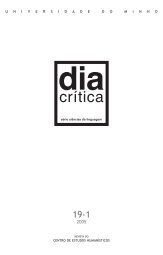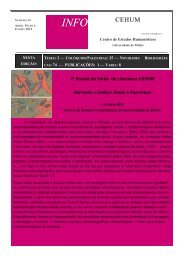Diacritica 25-2_Filosofia.indb - cehum - Universidade do Minho
Diacritica 25-2_Filosofia.indb - cehum - Universidade do Minho
Diacritica 25-2_Filosofia.indb - cehum - Universidade do Minho
Create successful ePaper yourself
Turn your PDF publications into a flip-book with our unique Google optimized e-Paper software.
BETTERNESS, SPECTRUM CASES AND THE CHALLENGE TO TRANSITIVITY IN AXIOLOGY<br />
135<br />
better than others. Some of those who defend this idea may simply say that<br />
global betterness is not transitive with local betterness. But others may reject<br />
altogether the idea of global betterness. Finally, there may be others who<br />
accept that notion but, when faced with a set of options in which our preferences<br />
are intransitive, fail to see any reason to consider any of them the best<br />
option. For them, any alternative within the spectrum can be chosen.<br />
In fact, those who hold this view face the same problem when it comes<br />
to any set of intransitive preferences. In order to avoid the risk of being<br />
money-pumped, they would have to arbitrarily stop at some point. In the<br />
same vein, when asked to choose some alternative among all the ones available<br />
in the spectrum, they may choose any of them arbitrarily.<br />
(ii) Primacy of principles. If we think our decision must be guided by<br />
the two principles that apply here (that is, the minimization of the duration<br />
and the intensity of the pain) we will reject a ponderation of our preferences<br />
such as the one made above, which is based merely on our intuitions<br />
towards particular outcomes. Our decision will be made, rather, in accordance<br />
to how we think that the two diff erent dimension of (dis)value that are<br />
at stake here (quantity and quality of pain) are to be combined.<br />
If we think they need to be considered on equal grounds, without any<br />
of them trumping over the other one at any time, the only possible solution<br />
available to us is A 1 (see for instance Norcross, 1998).<br />
If we assume that the combination of the two criteria in question here<br />
(quality and quantity of pain) must be carried out in accordance to the critical<br />
levels approach, our conclusion will be diff erent. We may then think<br />
that there is a value p that x may have, such that for any value of x which is<br />
lower than p, quantity and quality of pain can be traded, but for any value<br />
of x which is equal to or higher than p, quantity of pain is a trump. And,<br />
equally, we may think that there is another value q that x may have such<br />
that for any value of x higher than q, quantity and quality of pain can be<br />
traded, but for any value of x equal to or lower than q, quality of pain is a<br />
trump – this can be defended either because the absolute (dis)value of the<br />
quality and quantity of the pain which corresponds to A p and A q or because<br />
of the diff erence in pain between, say, A 1 and A p and A q and A n . So the best<br />
options would be those higher than A p and lower than A q . And it appears<br />
to be the case that A p >A p+1 >A p+2 > … >A q-2 >A q-1 >A q . Given this, A p would be<br />
the best option.<br />
Th is entails that the better outcome is not the one in which we experience<br />
some very mild pain for a long time, but one in which we undergo<br />
some more signifi cant pain (though not really like terrible torture) for a<br />
<strong>Diacritica</strong> <strong>25</strong>-2_<strong>Filosofia</strong>.<strong>indb</strong> 135 05-01-2012 09:38:26











![Programa [pdf] - cehum - Universidade do Minho](https://img.yumpu.com/17305425/1/190x135/programa-pdf-cehum-universidade-do-minho.jpg?quality=85)




